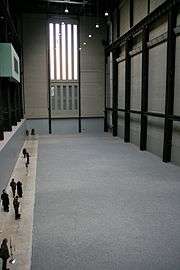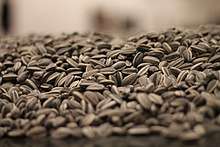Sunflower Seeds (artwork)
Kui Hua Zi (Sunflower Seeds) is an art installation created by contemporary artist and political activist Ai Weiwei. It was first exhibited at the Tate Modern art gallery in London from October 2010 to May 2011. It is a commentary on the mass production techniques that China caters to Western countries.
| Sunflower Seeds | |
|---|---|
 Ai Weiwei's Sunflower Seeds in the Tate Modern | |
| Artist | Ai Weiwei |
| Year | 2008 |
| Medium | Porcelain |
| Location | Tate Modern, London |
| Website | www |
Viewers were originally able to interact and walk across the sunflower seeds, but after the Tate Modern Museum recognized that the dust emitting from the installation was harmful to viewers' lungs, they fenced it off. The piece has been exhibited in twelve exhibitions from 2009-2013 in museums and galleries across the world.[1]
Background
Ai Weiwei is a conceptual artist in China. Towards the later 20th century, he led societal movements challenging the Chinese Communist Party. Ai has felt the presence and pressures of the society that the Chinese government has imposed on the peoples, and that is generated into his artwork. "From a very young age I started to sense that an individual has to set an example in society", he has said. "Your own acts and behaviour tell the world who you are and at the same time what kind of society you think it should be."[2]
Process
This massive art installation includes over 100 million porcelain sunflower seeds that cover a 1,000 square metre floor with a depth of 10cm in the Tate Modern's Turbine Hall. The entire artwork weighs around 150 tons. Each seed went through a 30 step procedure, hand painted and fired at 1,300 degrees.[3] This process required more than 1,600 workers over a span of two and a half years in Jingdezhen, a town known as the "Porcelain Capital", and has produced the imperial porcelain for over a thousand years. Ai began the process two-and-a-half years before its exhibition at the Tate Modern.[4]
Influence/Context

Sunflower seeds were a common theme in the Chinese Communist Party's political propaganda during Ai's childhood. Leader Mao Zedong would often represent himself as the sun, and the people of China as seeds on sunflowers in artworks. Ai also explains that when he was growing up, even the poorest families in China could share the seeds as a treat. The seeds represent optimism during difficult times.[2]
Interpretation
When looking at the seeds up close in Tate Modern's Turbine Hall, picking out each unique seed proves to be an easy task. However, when standing farther back once each of the 100 million seeds is deposited in a neat and orderly fashion, altogether a sense of expanse and immenseness is felt by the viewers.[2] The millions of individually created seeds spread across such a wide space are meant to symbolize the vastness of China, and its uniform and precise order. An individual seed is instantly lost among the millions, symbolizing the conformity and censorship of the Communist Party of China. The combination of all the seeds represent that together, the people of China can stand up and overthrow the Communist Party of China.
Most of Ai's artworks and projects carry this theme of making the Chinese Government's faults transparent to the rest of the world, as well as encouraging freedom of expression and strength to act. Along with this, the seeds represent China's growing mass production stemming from the consumerist culture, particularly that in the Western world, upon which Chinese exporters rely. The sculpture directly challenges the "Made in China" mantra that China is known for, considering the labor-intensive and traditional method used to create the work.[5] The work triggered inquiries from the viewers of the piece about their society and the effects of consumerism.[2]
Notes and references
- "List of Exhibitions: - Ai Weiwei's Sunflower Seeds".
- "The Unilever Series: Ai Weiwei: Sunflower Seeds: Interpretation text - Tate".
- "About Ai Weiwei's Sunflower Seeds". Faurschou Foundation. Retrieved 30 March 2017.
- "About Ai Weiwei's Sunflower Seeds." Ai Weiwei. Faurschou Foundation, n.d. Web. 29 Mar. 2017.
- "About Ai Weiwei's Sunflower Seeds." Ai Weiwei. Faurschou Foundation, n.d. Web. 29 Mar. 2017.
References
- About Ai Weiwei's Sunflower Seeds. (n.d.). Retrieved March 9, 2017, from http://www.aiweiweiseeds.com/about-ai-weiweis-sunflower-seeds
- Debin, M. L. (n.d.). Subversive Seeds. Retrieved March 13, 2017, from https://www.khanacademy.org/humanities/ap-art-history/global-contemporary/a/sseeds-ai-weiwei
- http://www.tate.org.uk/whats-on/tate-modern/exhibition/unilever-series-ai-weiwei/interpretation-text
External links
- Ai Weiwei – Sunflower Seeds (video). Tate.
- "The Unilever Series: Ai Weiwei: Sunflower Seeds: Interpretation text". Tate.
- Jervis, John. "Sunflower Seeds Ai Weiwei". ArtAsiaPacific (March/April 2011 ed.).